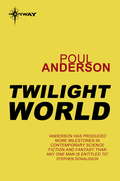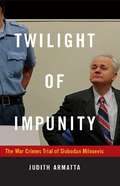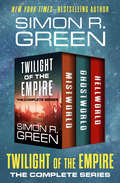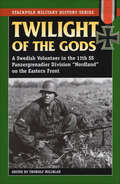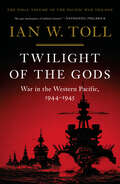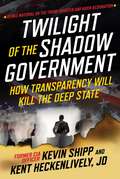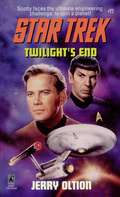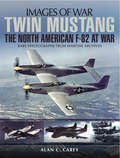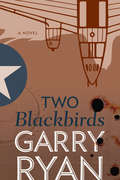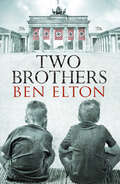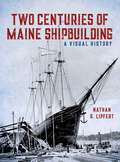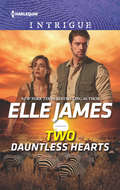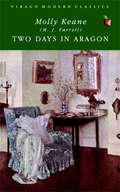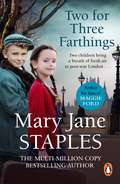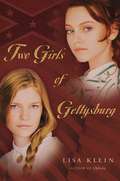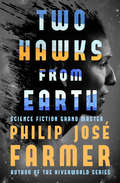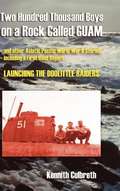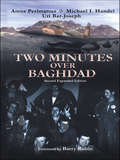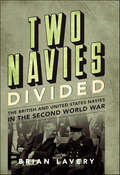- Table View
- List View
Twilight World: The Winter Of The World And Twilight World
by Poul AndersonAnother war, the most terrible nuclear disaster in the history of man has scorched and crippled all life on the surface of earth. In a few isolated zones human survival has occurred. Among these groups the birth rate is said to be phenomenal. There are reports of strange mutations of the human species appearing as frequently as fifty or sixty in a hundred births. Only a few of these strange mutations have been strong enough to survive, but some are reported to be reproducing their kind. A physical and mental examination of these freaks is being undertaken at the present time.
Twilight of Impunity: The War Crimes Trial of Slobodan Milosevic
by Judith ArmattaAn eyewitness account of the first major international war-crimes tribunal since the Nuremberg trials, Twilight of Impunity is a gripping guide to the prosecution of Slobodan Milosevic for war crimes, crimes against humanity, and genocide. The historic trial of the "Butcher of the Balkans" began in 2002 and ended abruptly with Milosevic's death in 2006. Judith Armatta, a lawyer who spent three years in the former Yugoslavia during Milosevic's reign, had a front-row seat at the trial. In Twilight of Impunity she brings the dramatic proceedings to life, explains complex legal issues, and assesses the trial's implications for victims of the conflicts in the Balkans during the 1990s and international justice more broadly. Armatta acknowledges the trial's flaws, particularly Milosevic's grandstanding and attacks on the institutional legitimacy of the International Criminal Tribunal. Yet she argues that the trial provided an indispensable legal and historical narrative of events in the former Yugoslavia and a valuable forum where victims could tell their stories and seek justice. It addressed crucial legal issues, such as the responsibility of commanders for crimes committed by subordinates, and helped to create a framework for conceptualizing and organizing other large-scale international criminal tribunals. The prosecution of Slobodan Milosevic in The Hague was an important step toward ending impunity for leaders who perpetrate egregious crimes against humanity.
Twilight of the Empire: The Complete Series (Twilight of the Empire #2)
by Simon R. GreenIn this trilogy set in the Deathstalker universe, the New York Times–bestselling author delivers “lots of action” and “exotic dangers” (Science Fiction Chronicle). Gathered here into a single volume, the novels in Simon R. Green’s Twilight of the Empire series take place before Owen Deathstalker’s rebellion in the same universe. An empire that once peacefully united galaxies in harmony is now rotten with corruption and ruled by a mad empress, threatened by outside alien invasion and violent internal rebellion. Against this background, “Green moves his plot at top speed” and delivers action-packed adventures set on three different worlds (Asimov’s Science Fiction Magazine). Mistworld: A rebel planet, cut off from the fruits of the Empire by a punishing blockade, Mistworld is a refuge for criminals, traitors, and exiles. Under a harsh medieval order, the strong rule, the weak perish, and everyone steals. A legendary Siren, possessed of terrible mental powers, Investigator Topaz is one of the few honest ones left. And when the Empire attempts to attack the psionic shield that protects Mistworld, she is the only one who can save them, whether they deserve it or not . . . Ghostworld: Ten years ago, the indigenous people of Unseeli rose up in rebellion against the Empire. Captain John Silence led the massacre that left the natives extinct and the planet uninhabited, except for the engineers who mine its invaluable metals. But when communication is abruptly cut off from the mining settlement, Captain Silence must return to find out what’s gone wrong—and confront the ghosts that still haunt his nightmares . . . Hellworld: Disgraced naval officer Scott Hunter is given a choice: get drummed out of the Imperial starfleet or join a suicide mission with the Hell Squad. One-way planetary scouts, the Hell Squad is made up of outcasts who explore new worlds for colonization. They survive or they die, but they never come back. Hunter leads a motley team of hard-nosed rebels to the volcano planet of Wolf IV, where they discover an ancient city and awaken a race of aliens. And now it’s kill or be killed . . .
Twilight of the Gods: A Swedish Volunteer in the 11th SS Panzergrenadier Division "Nordland" on the Eastern Front (Stackpole Military History Series)
by Thorolf HillbladA rare account of a non-German, Erik Wallin, who fought in the Nazi Party&’s Waffen-SS during World War II—a no-holds-barred narrative of the Eastern Front. This is the exciting true story of Erik Wallin, a Swedish soldier who volunteered for the Waffen-SS during World War II. Wallin served in the Panzer Reconnaissance Battalion of the 11th SS Panzergrenadier Division &“Nordland,&” a unit composed largely of men from Denmark, Norway, and Sweden. Sent to the Eastern Front, the 11th SS fought in the Courland Pocket in late 1944 and then battled the Red Army along the Oder River and in Berlin, where the Soviets destroyed the division. Few memoirs of non-Germans in the Waffen-SS exist, and Twilight of the Gods ranks among the very best. &“Provides an insight into how a Waffen-SS soldier reflects on the recent past . . . [and] how the SS myth was created . . . direct and raw.&” —Samuel de Korte, Traces of War
Twilight of the Gods: A Swedish Waffen-SS Volunteer's Experiences with the 11th SS-Panzergrenadier Division 'Nordland', Eastern Front 1944–45
by Thorolf HillbladA rare, first-hand account from a Swedish Waffen-SS soldier who fought against the Red Army on the Eastern Front during World War II.Few new personal accounts by Waffen-SS soldiers appear in English; even fewer originate from the multitude of non-German European volunteers who formed such an important proportion of this service’s manpower. Twilight of the Gods was originally written in Swedish, and published in Buenos Aires shortly after the end of WWII. It is the story of Erik Wallin, a Swedish soldier who volunteered for service with the Waffen-SS, and participated in the climactic battles on the Eastern Front during late 1944 and 1945, as told to this book’s editor, Thorolf Hillblad.Wallin served with the Panzer Reconnaissance Battalion, 11th SS-Panzergrenadier Division Nordland, a unit composed mainly of non-German volunteers, including Danes, Norwegians, and Swedes. The division enjoyed a high reputation for its combat capability, and was always at the focal points of the fighting on the Eastern Front in the last year of the war. During this period, it saw combat in the Baltic, in Pomerania, on the Oder, and finally in defense of Berlin, where it was destroyed.Erik Wallin served with his unit in all of these locations, and provides the reader with a fascinating glimpse into these final battles. The book is written with a “no holds barred” approach which will captivate, excite and maybe even shock the reader—his recollections do not evade the brutality of fighting against the advancing Red Army. Twilight of the Gods is destined to become a classic memoir of the Second World War.
Twilight of the Gods: War In The Western Pacific, 1944-1945 (The Pacific War Trilogy #3)
by Ian W. TollNew York Times Bestseller The final volume of the magisterial Pacific War Trilogy from acclaimed historian Ian W. Toll, “one of the great storytellers of War” (Evan Thomas). In June 1944, the United States launched a crushing assault on the Japanese navy in the Battle of the Philippine Sea. The capture of the Mariana Islands and the accompanying ruin of Japanese carrier airpower marked a pivotal moment in the Pacific War. No tactical masterstroke or blunder could reverse the increasingly lopsided balance of power between the two combatants. The War in the Pacific had entered its endgame. Beginning with the Honolulu Conference, when President Franklin Delano Roosevelt met with his Pacific theater commanders to plan the last phase of the campaign against Japan, Twilight of the Gods brings to life the harrowing last year of World War II in the Pacific, when the U.S. Navy won the largest naval battle in history; Douglas MacArthur made good his pledge to return to the Philippines; waves of kamikazes attacked the Allied fleets; the Japanese fought to the last man on one island after another; B-29 bombers burned down Japanese cities; and Hiroshima and Nagasaki were vaporized in atomic blasts. Ian W. Toll’s narratives of combat in the air, at sea, and on the beaches are as gripping as ever, but he also reconstructs the Japanese and American home fronts and takes the reader into the halls of power in Washington and Tokyo, where the great questions of strategy and diplomacy were decided. Drawing from a wealth of rich archival sources and new material, Twilight of the Gods casts a penetrating light on the battles, grand strategic decisions and naval logistics that enabled the Allied victory in the Pacific. An authoritative and riveting account of the final phase of the War in the Pacific, Twilight of the Gods brings Toll’s masterful trilogy to a thrilling conclusion. This prize-winning and best-selling trilogy will stand as the first complete history of the Pacific War in more than twenty-five years, and the first multivolume history of the Pacific naval war since Samuel Eliot Morison’s series was published in the 1950s.
Twilight of the Shadow Government: How Transparency Will Kill the Deep State
by Kent Heckenlively Kevin ShippIn this groundbreaking book, Kevin Shipp, a veteran CIA agent who worked with all four Directorates of the agency, including protecting the head of the CIA, provides his perspective on how the agency has strayed so far from its original mission to provide accurate intelligence to the American president. You will learn about the founding of the Agency, how the intelligence agencies have manipulated journalists through Project Mockingbird, as well as their new efforts with the Center for Global Engagement and Big Tech interference. Shipp will also give you his up close and personal assessment of how the directors of the agency have contributed to our safety or undermined it. Shipp and Heckenlively detail how the CIA has blocked whistleblowers and the reforms they champion, while also controlling our country through secret alliances with large corporations, Wall Street, Big Media, the drug trade, and blackmail of our political leaders. Shipp provides his own history with the Agency, both the good and bad, including the Agency&’s attempt to ruin his career and life when he turned whistleblower. Perhaps most striking of all, Shipp lays out his plan for a dramatic overhaul of the Agency, likely to win wide approval from other sectors of the intelligence community, restoring the freedom of our country, while also keeping us safe from our adversaries.
Twilight's End (Star Trek: The Original Series #77)
by Jerry OltionUnlike most planets, Rimillia does not spin upon its axis so its day and night sides are subject to perpetual extremes of hot and cold. Habitation has only been possible on a thin band of the planet's surface...until now. Using gigantic impulse engines of unimaginable power, the alien Dumada intend to start Rimillia rotating, rendering the entire world fit for colonization. Yet some fear the enormous stresses involved may tear the planet apart. Assigned to assist the Dumada, Captain Kirk must rescue a kidnapped scientist vital to the rotation project. But, once the giant engines are activated, can even Scotty save Rimillia -- and the U.S.S. Enterprise -- from total destruction.
Twin Mustang: The North American F-82 at War (Images of War)
by Alan C. Carey&“A comprehensive look at the 272-plane F-82 fleet . . . This is a fine addition to Carey&’s body of work and to anyone&’s aviation library.&”—HistoryNet One of the most unusual and remarkable American fighter aircraft, the F-82 Twin Mustang was the last mass production propeller-driven fighter acquired by the U.S. Air Force. Originally intended as a very long-range fighter escort for the Boeing B-29 Superfortress during World War II, it arrived too late to see combat and evolved into a night and all-weather fighter during the post-war years. Combat operations in the Korean War followed, along with a host of other dynamic episodes of deployment. This work traces the developmental, operational, and combat history of this unique American fighter and features 120 photographs and illustrations, many of which have never been published before. Seven chapters, all extensively illustrated, cover the aircraft&’s development, descriptions of the variants and sub-types, details of initial entry into service, three chapters covering the F-82&’s service in the Korean War, and a final chapter detailing the type&’s removal from the Korean War Theatre in February 1952, to see out its operational days in the Alaskan Air Defense Command. &“If you&’re an historian like me, you&’ll love this book. It lists every F-82 to serve in Korea, every crewman lost in combat, every squadron which used them, and all the pertinent tech details about each version. Photos illustrate the planes from nearly every squadron (if not all) and captions offer in-depth information not included in the text—so they really add value.&”—My Hobby Info
Twins for the Soldier (American Heroes #45)
by Rochelle AlersHe came home for a mission…Will he end up with a family?Army ranger Lee Remington didn’t think he’d ever go back to Wickham Falls, home of some of his worst memories. Now, returning home to help his sister, he’s shocked by a powerful attraction to military widow Angela Mitchell…and floored by this mother of toddler twins, who accepts his proposal. But as he preps for his ready-made family, there’s one thing Lee forgot to tell her…
Twist of Faith: Twist of Faith (Star Trek: Deep Space Nine)
by Jeffrey Lang Weddle David Keith R. DeCandido S.D. PerryUneasy peace. Worlds in flux. Tests of faith. The final episode was only the beginning.The Dominion War is over...or is it? Three months after the Allied victory against the invaders from the Gamma Quadrant, a surprise attack awakens the fear of renewed hostilities. At the same time, a senseless murder sets a space station commander on a path that will test the limits of her faith...while a strange discovery within the plasma storms of the Badlands propels an old soldier toward a rendezvous with destiny. Elsewhere, amidst the ruins of an ancient civilization, a young man is about to embark on a dangerous quest to fill the hole in his life—one left by the loss of his father. So begins the unprecedented, authorized continuation of Star Trek: Deep Space Nine®, springing from the seven-year television odyssey of Captain Benjamin Sisko and his crew aboard a Federation starbase at the edge of the final frontier. Following the serial format and evolving character arcs that were the hallmarks of the TV series, the new Deep Space Nine novels pick up where the show left off, daring to imagine what happened after the final episode. Now the first five tales of that critically acclaimed storyline are collected in one massive volume. Originally published as the two-part Avatar, Abyss, Demons of Air and Darkness, and the novella Horn and Ivory, Twist of Faith revisits the aftermath of the Dominion War, the pivotal planet Bajor, its mysterious connection to the timeless Prophets of the wormhole, as well as the familiar faces, new friends, and uncertain allies whose fates intertwine at the crossroads of the galaxy. With an introduction by New York Times bestselling author David R. George III (Mission: Gamma—Twilight; The Lost Era: Serpents Among the Ruins; the Crucible trilogy), Twist of Faith takes the Deep Space Nine saga to a new level, exploring what was left behind and what awaits beyond.
Two Blackbirds: A Novel (Blackbirds #2)
by Garry RyanThe fires of the Second World War are beginning to burn down, but legendary Canadian aviatrix Sharon Lacey is not out of danger just yet. Complications enter the young ace's life as deep-seated racial and class prejudice, potential fifth columnists and even her own killer code of honour threaten her hard-fought reputation, while a new and wonderful secret might also prove to be her undoing. Meanwhile, across the Channel in Fortress Europe, new weapons have started rolling off Nazi production lines, and the characteristic buzz of the deadly V-1 flying bomb fills the air. In the second act of his Calgary Herald-bestselling Blackbirds trilogy, Garry Ryan pits his intrepid heroine against an array of deadly new foes and challenges, proving that in war the enemy may wear the same uniform as your own.
Two Brothers: A Novel
by Ben EltonBestselling author Ben Elton's most personal novel to date, Two Brothers transports the reader to the time of history's darkest hour.Berlin 1920Two babies are born.Two brothers. United and indivisible, sharing everything. Twins in all but blood.As Germany marches into its Nazi Armageddon, the ties of family, friendship and love are tested to the very limits of endurance. And the brothers are faced with an unimaginable choice... Which one of them will survive?
Two Centuries of Maine Shipbuilding
by Nathan LipfertFrom the moment colonists at Popham launched the first ship constructed in the New World in 1608, Maine has been a shipbuilding powerhouse. Celebrating the bicentennial of Maine, historian Nathan Lipfert, in cooperation with the Maine Maritime Museum explores the rich history of Maine shipbuilding. Though concentrating primarily on shipbuilding activity in the two centuries since statehood, the book begins with pre-1820 activity, including native canoe-making (the oldest known birchbark canoe is in a Maine museum) and colonial-period shipbuilding. Covering the entire coast, this rich visual history focuses on the industry and the vessels produced, highlighting Maine&’s national and international importance in shipbuilding over the past two centuries, and its continuing relevance to national security, the fisheries, yachting and harbor craft.
Two Dauntless Hearts: Two Dauntless Hearts (mission: Six) / Texas Grit (crisis: Cattle Barge) (Mission: Six #2)
by Elle JamesIn one of the most remote locationsA SEAL meets his match…Stationed in Africa, SEAL “Pitbull” Percy Taylor is on leave and flying to Kenya for a safari. Until bush pilot Marly Simpson is forced to crash-land their plane on the savanna. Stranded together, the itinerant pilot and the roving SEAL find a connection neither dreamed possible. And when Marly and her plane disappear, Pitbull rallies his SEAL team…to save the only woman he could ever truly love.MISSION: SIX
Two Days In Aragon (Virago Modern Classics #231)
by Molly KeaneGrania and Sylvia Fox live in the Georgian house of Aragon, with their mother, their Aunt Pidgie and Nan O'Neill, the family nurse. Grania is conducting a secret affair with Nan's son, Foley, a wily horse-breeder, whilst Sylvia who is 'pretty in the right and accepted way' falls for the charms of Captain Purvis. Attending Aragon's strawberry teas, the British Army Officers can almost forget the reason for their presence in Ireland. But the days of dignified calm at Aragon are numbered, for Foley is a member of Sinn Fein.
Two Days In Aragon (Vmc Ser. #55)
by Molly KeaneGrania and Sylvia Fox live in the Georgian house of Aragon, with their mother, their Aunt Pidgie and Nan O'Neill, the family nurse. Grania is conducting a secret affair with Nan's son, Foley, a wily horse-breeder, whilst Sylvia who is 'pretty in the right and accepted way' falls for the charms of Captain Purvis. Attending Aragon's strawberry teas, the British Army Officers can almost forget the reason for their presence in Ireland. But the days of dignified calm at Aragon are numbered, for Foley is a member of Sinn Fein.
Two Eggs on My Plate
by Oluf Reed Olsen'Two Eggs on My Plate,' written by Oluf Reed Olsen. Retold by John Kennett.
Two For Three Farthings: the perfect feel-good Cockney tale that is certain to your warm your heart
by Mary Jane StaplesA brilliantly moving story of misfits finding a place to belong, perfect for fans of Maggie Ford, Kitty Neale and Katie Flynn. The ideal novel to escape with for an afternoon...READERS ARE LOVING TWO FOR THREE FARTHINGS'I couldn't put it down!' - 5 STAR REVIEW'Another brilliant read from Mary Jane Staples' - 5 STAR REVIEW'Hilarious and heart-warming' - 5 STAR REVIEW'An ideal book to relax with' - 5 STAR REVIEW*********************************************************TWO CHILDREN BRING A BREATH OF FRESH AIR TO LONDON...Horace was ten, Ethel seven, when Jim Cooper, home from the trenches, minus an arm and just about managing on his own, found them huddled in a doorway on a wet night in Walworth. Slightly against his better judgement he took them in, fed them cocoa, and put them to sleep in his bed.A few days later he found that - somehow - he had become the unofficial guardian of Horace and Ethel. It was him, the orphanage, or separation for the gutsy little pair and Jim felt a sudden affinity for the two cheeky cockney kids. First, he had to find lodgings for them all.Miss Rebecca Pilgrim was a woman of strict Victorian principles, eminently respectable, and determined to keep her privacy intact. She had reckoned without her new lodgers - Horace, Ethel and, above all, the irrepressible Jim Cooper.And thus began the humanizing of Miss Pilgrim, who turned out to be younger, prettier, and far gentler than any of them had suspected...
Two Fronts (The War That Came Early #5)
by Harry TurtledoveIn 1942, two nations switch sides--and World War II takes a horrifying new course. In the real world, England and France allowed Adolf Hitler to gobble up the Sudetenland in 1938. Once Hitler finished dismembering Czechoslovakia, he was ready to go to war over Poland a year later. But Hitler had always been eager to seize Czechoslovakia, no matter the consequences. So what if England and France had stood up to the Nazis from the start, and not eleven months later? That is the question behind the War That Came Early series. Four years later, the civil war in Spain drags on, even after General Franco's death. The United States, still neutral in Europe, fights the Japanese in the Pacific. Russia and Germany go toe-to-toe in Eastern Europe--yet while Hitler stares east, not everything behind him is going as well as he would like. But nothing feeds ingenuity like the fear of losing. The Germans wheel out new tanks and planes, Japan deploys weapons of a very different sort against China, and the United States, England, and France do what they can to strengthen themselves against imminent danger. Seen through the eyes of ordinary citizens caught in the maelstrom, this is a you-are-there chronicle of battle on land and sea and in the air. Here are terrifying bombing raids that shatter homes, businesses, and the rule of law. Here are commanders issuing orders that, once given, cannot be taken back. And here are the seeds of rebellion sown in blood-soaked soil. In a war in which sides are switched and allies trust one another only slightly more than they trust their mortal enemies, Nazi Germany has yet to send its Jews to death camps, and dangerous new nationalist powers arise in Eastern Europe. From thrilling submarine battles to the horror of men fighting men and machines all through Europe, Two Fronts captures every aspect of a brilliantly reimagined conflict: the strategic, the political, and the personal force of leaders bending nations to their wills.
Two Girls of Gettysburg
by Lisa KleinWhen the Civil War breaks out, two cousins, Lizzie and Rosanna, find themselves on opposite sides of the conflict until the war reunites them in the town of Gettysburg.
Two Hawks from Earth
by Philip José FarmerFrom the New York Times–bestselling author of the Riverworld series: An alternate history classic in which the American continents never existed. Two Hawks from Earth, an expanded and revised version of Philip José Farmer&’s The Gate of Time, is the story of an Iroquois pilot in World War II. First Lt. Roger Two Hawks is on a bombing run over Romania when his aircraft is shot down and collides with a German plane midair. Two Hawks bails out and survives, but when he reaches the ground, gone are the suburbs he saw from the sky. Instead, there are dirt roads, trees, farms, and an unsettling quiet. Then Two Hawks sees the soldiers: fur-clad men with shiny steel helmets shaped like wolf heads and armed with swords and arrows. Soon he comes to understand that, though a world war still rages, the Americans are absent—because they don&’t exist, and neither does the land they&’d come from. With his modern-day military and technical knowledge, Two Hawks becomes a prize that both armies covet. But he&’ll have to learn to play by the rules of a new realm in order to survive—and live to see another world . . . Praise for Philip José Farmer &“An excellent science fiction writer.&” —Isaac Asimov &“[Farmer&’s work is a] blend of intellectual daring and pulp fiction prose.&” —The New York Times &“Farmer offers his audience a wide-screen adventure that never fails to provoke, amuse, and educate. . . . His imagination is certainly of the first rank.&” —Time on The World of Tiers
Two Hundred Thousand Boys on a Rock Called GUAM
by Kennith CulbrethFrom book jacket: The purpose of these writings is to give the reader a "feel" for what it was like to be a teenager in a very slow moving world; then suddenly be jerked into a life style that you weren't at all prepared for. To see the different ways that people, cut from the same fabric, react in times of stress and change, can be devastating, or heart warming. It is at such times that we realize that we, in a way, are all strangers, and most don't know ourselves very well.
Two Minutes Over Baghdad
by Amos Perlmutter Uri Bar-Joseph Michael HandelA detailed account of the way Israel dealt with the Iraqi nuclear buildup between its launch in 1974 and the destruction of the Tamuz I reactor on 7 June 1981. This updated account includes formerly classified information and photographs taken during the mission and from US spy satellites.
Two Navies Divided: The British and United States Navies in the Second World War
by Brian LaveryThe title is derived from George Bernard Shaw’s comment that ‘England and America are two countries divided by a common language.’ It is not intended to imply that the two navies were seriously at odds with one another, but rather to suggest, as in the case of language, that common roots and usages varied significantly. And the Second World War is a pertinent moment for comparison. They fought on the same side against a common enemy for nearly four years, but Britain fought the war for the survival of itself and its empire, though in the long term it failed with the latter, while the American government fought to maintain its influence through the balance of power; its people fought for revenge for Pearl Harbor, and out of a sense of justice. In this new book, Brian Lavery describes and analyzes the differences and similarities between the two navies and in doing so sheds fascinating light on how the naval war was fought. For example, both navies had spectacular failures after entering the war – the Royal Navy off Norway, the USN at Pearl Harbor and Savo Island. Paradoxically, both commenced the war with quite amateur performances by professional navies and ended with highly skilled performances by largely amateur manned forces. The training systems for regular officers had flaws in both countries. In Britain, entry was largely dependent on family income, in America, on political influence. But American officers probably had a broader perspective by the time they entered active service. The book covers ships and weapons systems – for instance, the British used too many gun types in the 4 to 6in range, while the Americans concentrated on the well-designed 5in. And the author describes conditions onboard ships. British vessels were awash with alcohol, which had its attractions for Americans when alongside; the Americans offered ice cream in return. These examples represent only a tiny proportion of the subjects covered in this stimulating analysis. Aviation, the marines of both navies, anti-submarine and mine warfare, uniforms, propulsion systems, shipbuilding and building programs, commanders and national leaders, ratings and officers, ship design, geographical environments, naval bases, hammocks and bunks, the deployment of women – these are among the myriad big and small themes that will open the eyes of naval historians and enthusiasts, and show anyone with an interest in the Second World War how these two great allies came together to defeat the Axis forces.
